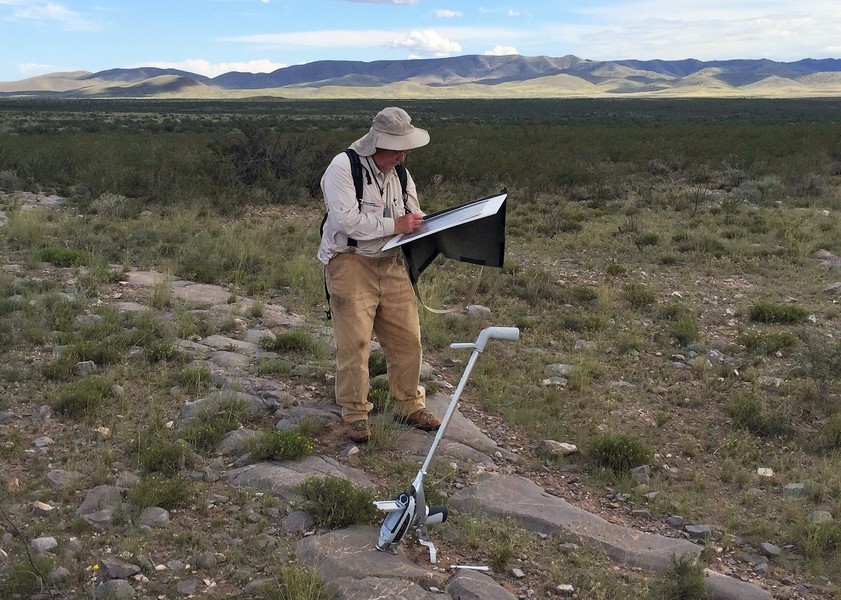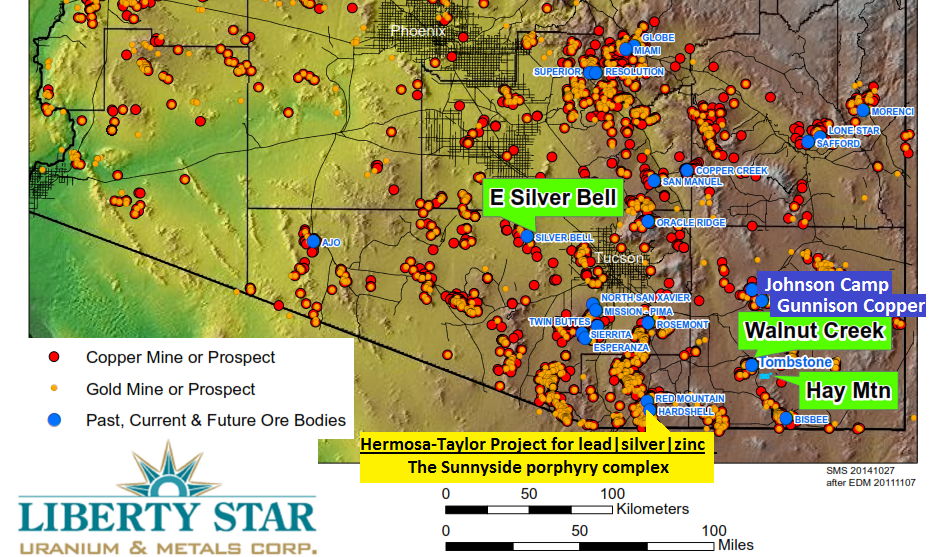
Jim Briscoe at the Hay Mountain Project
James A. Briscoe Chairman, CEO, Chief Geologist
Liberty Star Uranium & Metals Corp. [LBSR: OTCPK]
Congratulations to Arizona Mining (CN: AZ) on the news they issued last Tuesday, Arizona Mining Reports Significant High-Grade Drill Results in a New Copper-Rich Zone at the Taylor Project. I reviewed with great interest their statements and the cross-section data regarding what they are finding in their latest step-out drilling program focused on expansion of the Taylor Deeps Zone located on their Hermosa Project, Santa Cruz County, Arizona.
Arizona Mining calls the results “robust” for the 2 drill holes discussed in the news release, and they are correct in that assessment. I believe we will see similar findings at the Hay Mountain Project 35 miles [56.3 km] northeast in Cochise County. From this latest release of information, it appears that as they drill deeper they will find higher grades of silver & copper, lower of zinc as they pass through that zone, “Epitaph dolomite”, on their way the prolific Martin formation which was the bonanza grade copper host at Bisbee and other Arizona mines. Luckily for Arizona Mining the new copper zone is high grade and is undefined to the north and south of the current zone. The initial finding is substantial enough that Arizona Mining will investigate how it needs to modify its milling plans to include copper processing.
Hay Mountain Project Update: We have conducted in-depth single day and multi day tours of the Hay Mountain Project and surrounding areas. What we seek to demonstrate during a technical tour is the consistency of our surface study findings, and geophysical data demonstrating a large magnetic body(ies) and EM (electromagnetic) response from disseminated mineralization with what is known about adjacent areas. Independent geologists and geophysicists have evaluated our contracted data and find it is correct in its interpretation by our consultants. For example, geochemist Shea Clark Smith has hosted experts at his sample preparation laboratory located north of Carson City, Nevada, and reviewed sampling protocols with them. This resulted in high satisfaction with his methodology by the experts.
As we have noted, the Hay Mountain Project is well positioned within the USGS Great Cluster of Copper & Gold Resources extending from Apache County, Arizona south into Sonora, Mexico including well established copper mines such as the complexes at Ray, Sierrita, Mission-Pima, Morenci, Cananea and La Caridad. Bisbee, one of the highest-grade porphyry copper mines ever developed, is about 12 miles south of Hay Mountain. What we have in common with these sites:
- Layered limestone sediments, copper grades increase deeper
- While not an ore body, surface copper oxide in coarse marble over a very large area is an indication of a mineral resource to be taken seriously. What has happened in the Great Cluster economic ore bodies, as well as worldwide, is with drilling a change from mineral resource to defined ore body, if it can be mined at a profit, is shown. This happens as geotechnical evidence and financial viability mounts throughout the exploration process: from surface studies, to step-out drilling, to infill drilling, metallurgical engineering and mining engineering, then a bankable feasibility study and, on success of these studies, commencement of mining.
- Fragmented mineralization in breccia: long recognized throughout the Hay Mountain exploration, has been recently recognized to be larger and more intense than previously recognized. This may influence the intensity and grade of mineralization at greater depth.
- Attendant metals, many of which could be commercial grade or co- or by-products: primarily moly (molybdenum) gold, and including, cobalt, lead, manganese, nickel, silver and zinc. The newly defined “battery metals” are included in this list.
While our surface studies are mutually reinforcing and provide credence to the Hay Mountain Project being typical of the other copper mines in the area (we believe the largest), nothing beats a physical tour of the ground. We can walk over numerous examples of disseminated surface occurrence of green copper oxide (malachite coming from the sulfide mineral chalcopyrite which is also typical of the ore bodies at Bisbee), strongly anomalous moly and detectable breccias to bring home the Hay Mountain story.
To fulfill Arizona State Land Department maintenance requirements, we continue with a program of carefully executed XRF (x-ray fluorescence) ground studies, and geology. We hope to suspend these studies soon and begin phase 1a step-out drilling. As we have mentioned, we have permits in hand and have selected the best contractors for the job. We await funds to shift from surface maintenance activities to diamond core drilling.
RISK FACTORS FOR OUR COMPANY ARE SET OUT IN OUR 10-K AND OTHER PERIODIC FILINGS WITH THE SEC ON EDGAR.

